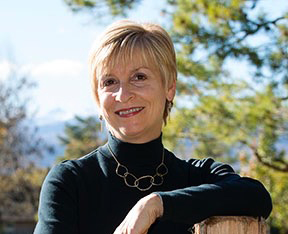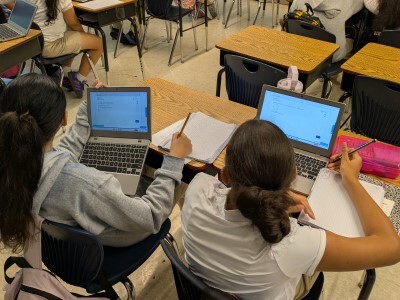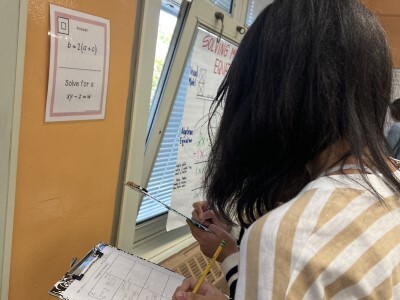It Takes a Village: Community Partnerships for Real-World Learning
Topics
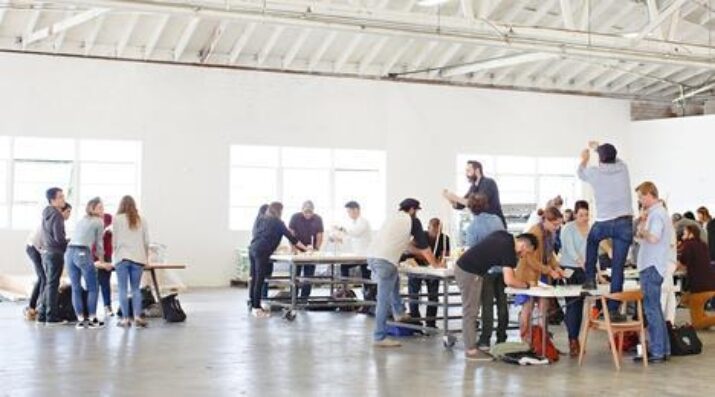
We’ve all had the experience of truly purposeful, authentic learning and know how valuable it is. Educators are taking the best of what we know about learning, student support, effective instruction, and interpersonal skill-building to completely reimagine schools so that students experience that kind of purposeful learning all day, every day.
Practitioner’s Guide to Next Gen Learning
Exploring school systems that are leveraging strong community partnerships to provide real-world learning to students in middle and high school.
Real-world learning levels the playing field—providing access to job choices students often didn’t even know existed, choices previously available to only the more privileged.
—Natasha Morrison, Director of Real World Learning, Da Vinci Schools
Real-world learning is not new. Many of us can recall powerful learning experiences working with non-educator adults like the scientist who judged our 4H project, the engineer who coached our Robotics team, or the local business owner who led the Junior Achievement club. Projects like these were more than just engaging. They gave us a glimpse of some future version of ourselves—as scientists, engineers, designers, or entrepreneurs.
However, for a long time such experiences have existed at the periphery of our secondary school models, either as extracurriculars or as options for top performers or students with means. Next generation learning invites us to envision a longer-term, more equitable approach to learning, one that recognizes every adolescent as an adult-in-training. After all, students will spend 13 years inside our schools and the rest of their lives outside of them. How can we redesign our schools so that all learners have access to powerful experiences that prepare them for success in adult life? How might we show them a fuller range of possible futures they can aspire to?
This edition of NGLC's Practitioner’s Guide to Next Gen Learning is the first of a two-part series about three school systems that are leveraging strong community partnerships to provide real-world learning to students in middle and high school. For this installment, we spoke to school leaders at St. Vrain Valley School District in Longmont, CO, and Da Vinci Schools in Los Angeles, CA. Next, we will feature Vista Unified School District in Vista, CA. For this series, we’ve invited educators to share their stories in response to these questions:
- Why do you partner with external organizations?
- What do those partnerships look like—how does it work?
- What advice would you give to other schools and systems just getting started with real-world partnerships?
- What do those partnerships look like—how does it work?
- What advice would you give to other schools and systems just getting started with real-world partnerships?
High Schools, Industry, and Higher Ed Team Up in St. Vrain Valley
If you ask John Steckel, the director of the Innovation Center at St. Vrain Valley School District, about community partnerships, he can rattle off an impressive list of high school focus programs that offer real-world learning experiences as part of a career and college pathway. From the arts to STEM to aeronautics, the majority of St. Vrain’s high schools now offer real-world learning. In cooperation with the University of Colorado, Colorado State University, and Front Range Community College, as well as with local businesses, 9th grade students in St. Vrain schools can embark on a unique course of learning experiences leading not just to college credit but also to industry certifications, internships, and college degrees—while still in high school.
“An opportunity to re-evaluate and change the paradigm that came from educators themselves, rather than politicians or curriculum developers,” is how John describes the genesis of real-world learning and partnerships at St. Vrain. In 2013 the district was awarded a Race to the Top grant, and John points to this grant as the catalyst for St. Vrain’s transformation.
According to John, what was different about the Race to the Top grant was that it provided resources to those who were “in the work, and it was about making real change to the educational model. It allowed us to say, ‘if we are really going to change education, what do we need to do?’” Responding to that question, the district launched a project-based STEM pathway at Skyline, the district’s high school with the largest population of minority students and students receiving free or reduced price lunch. This was an intentional decision, a proof point that all students could experience success using the model.
Scaling success. John recounts how authentic learning took off as a result: observation of “how excited students were about doing real-world projects” in the STEM program at Skyline sparked interest throughout the K-12 system, from capstone projects to creating the Innovation Center to supporting connections to industry. Based on the initial success at Skyline, other schools in the district engaged with Design Thinking, which John describes as “a common thread, a method for educators to shift the way they approach projects,” including at the elementary and middle school levels.
Four years after receiving the four-year Race to the Top grant, Skyline High now features three focus programs: the STEM Academy, a Visual and Performing Arts Academy, and a new Pathways in Technology Early College High School (P-TECH) program. A partnership between St. Vrain Valley Schools, Front Range Community College, and IBM, P-TECH offers students the opportunity to graduate with both a high school diploma and a no-cost Associate of Applied Science in Computer Information Systems. This pathway also gives students a head start in a tech career through significant internship and mentorship opportunities at IBM.
Of flooding and frogs. “Business and industry are now asking student project teams to solve real-world problems,” John explains. “A staff member serves as project manager, but the students all have titles and roles, such as in engineering, finance, and communications for the project.” Media coverage of rescues during this past year’s devastating floods, for example, inspired students from Erie and Skyline High Schools to create a handheld emergency beacon that would assist first responders in locating people when cell phone service is disrupted by disaster. This innovative invention garnered a Lemelson-MIT InvenTeam Grant, which funds students to develop real-world solutions to serious problems.
The Denver Zoo also enlisted the help of students to support a group of Peruvian scientists who were studying frogs in a high-altitude lake. Leveraging both their engineering knowledge and their bilingual skills, the students built and provided tech support for a remotely operated underwater vehicle (ROV). News of this project caught the attention of City of Longmont officials, who are now discussing ways to use the ROV designs to accomplish underwater mapping of the city’s streams and reservoirs.
Mutual Benefit, Not Charity
Instead of asking businesses to write a check, John recommends that schools ask potential partners, “What are you looking for in your next workforce? How can we help you? Are we providing students with the best opportunities, the ones that would put their applications at the top of the pile?” In short, he says, “When you are not asking, but offering, they are so much more willing to engage.”
Framing the request this way has made partnerships appealing and contributed to their success. According to John, “We found a way to get students engaged, higher ed engaged, and industry engaged. They could see our buy-in and the students’ buy-in. For them the partnerships were going to provide college students and a workforce that had knowledge, experience, and the soft skills employers are really looking for. They were excited to see it happen and excited to support it.”
Real-World Learning for Both Educators and Students at Da Vinci
Project-based learning has been the instructional model at Da Vinci Schools, an NGLC grantee, since the beginning. Over the years, the role of external partnerships in providing real-world learning experiences has expanded and deepened. Today Da Vinci partners with over 20 diverse industries, including Belkin International, Gensler Architecture, 72andSunny, Boeing, and Northrop Grumman, as well as 10 colleges and universities.
For Da Vinci educators, real-world projects support multiple goals for students. In addition to developing students’ skills in problem solving, critical thinking, collaboration, and creativity, this approach is also closely tied to issues of equity. As Natasha Morrison, Da Vinci’s Director of Real-World Learning, explains, “Many students, especially low income ones, are not exposed to careers beyond the traditional doctor, lawyer, teacher. Through real-world experiences, students learn about the wide array of jobs that exist, many that never existed prior to tech, or in previous generations. We give them the opportunity to literally see themselves in these jobs.”
Although formal internships are not a graduation requirement at Da Vinci, about 40 percent of students participate, and there are enough internships to accommodate any who are interested. Students can also engage with partners through work experience seminars, mentorships, and workplace tours. Yet even if they do not take advantage of these options, all students reap the benefits via Da Vinci’s signature “project pitch panels.”
Rather than providing general feedback about alignment with workplace skills and habits, the pitch panels give guidance to individual teachers on how to design projects that are as authentic as possible. “As educators,” Natasha points out, “we have not worked in these industries, so we bring the industry to us.”
On pitch panel days, teachers present their project ideas to panels of relevant industry professionals. Using a standard feedback protocol, the experts offer advice on how to make the project more “real world.” They also suggest additional resources, software to use, or contacts for the classroom educator to consult. In this way, educators are supported to create curriculum and learning experiences that encompass both academic content and real-world application of knowledge.
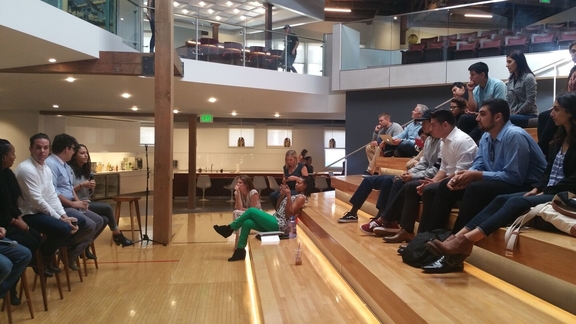
Start Small and Make It Easy for Partners to Engage
Today Da Vinci can point to deep, multi-year partnerships, but Natasha offers suggestions for schools that are either just getting started or are not located in a large urban center like Los Angeles. “Think small and local,” she advises. “Many businesses care about students and have a need, like getting support on how to use social media or serving on a focus group. It doesn’t have to be corporate.” In the past, Da Vinci has partnered with every kind of business, from a comic book shop to farmers’ markets.
Natasha also recommends starting small in terms of engagement. Partners can support student learning as guest speakers, pitch panel consultants, or even as remote mentors for skills like writing a professional email and sending a calendar invitation. As she puts it, “Once there’s a relationship, you can work on mutual benefit and expand beyond those initial roles.”
To create smooth and positive experiences for partners, Natasha highlights the importance of planning ahead: “Industry partners’ calendars are full, so give lots of lead time. If you want to do project planning in August, send out the forms in May or June.” To avoid bombarding your partners, she says, it is best to designate one point person to communicate with each external organization and track the roles they’ve played.
According to Natasha, industry partners benefit from exemplars and models. If schools provide sample agendas for workplace tours, templates, protocols, and other resources, partners avoid reinventing the wheel. For example, Da Vinci has built up a collection of partnership materials to reduce the burden on busy industry professionals and design experiences that are beneficial to both partners.
Partnerships do take time to implement well, but Abby Crocket, Brand Director at 72andSunny, cites the value to employees: “Working with kids is exciting. It takes employees back to when they were learning these things and reminds them of why they got into this business.”
Resources
- Da Vinci Schools’ Industry Partnership Resources Folder: Materials for industry outreach, pitch panels, and teacher training for real-world learning
- Lemelson-MIT InvenTeams: Information about the competition and this year’s awardees, including the invention by St. Vrain Valley School District students
- Promising Practice: How St. Vrain Valley Schools built trailblazing STEM program: From Colorado Education Highlights, a Colorado Department of Education publication, about Skyline High School’s STEM pathway
- P-TECH flyer: A student-facing brochure about Falcon Tech, St. Vrain’s P-TECH Pathway NGLC
- MyWays Report 5: Research and resources on preparing apprentice-adults for life after high school
Read part 2, It Takes a Village: Talent Cities at Vista Unified

